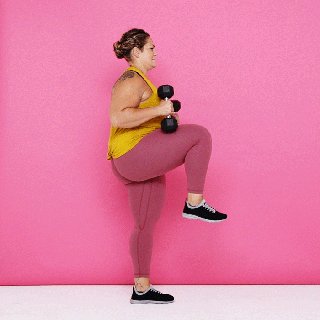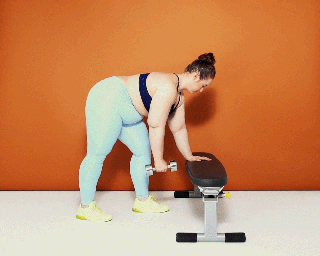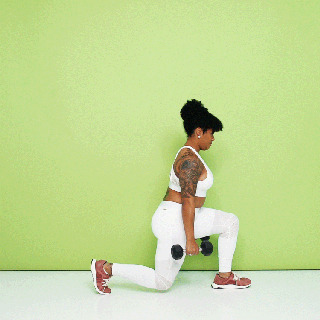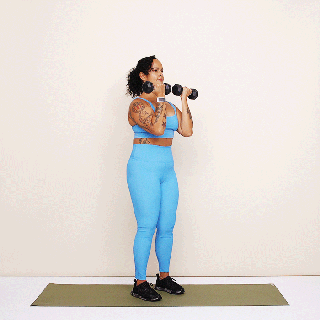Anyone new to strength training can benefit from an awesome beginner dumbbell workout that hits all the major muscle groups with simple, effective movements. And that’s exactly what we have right here: A four-move routine you can do at home to master the basics—no intimidating equipment or exercises needed.
In this full-body dumbbell workout, the focus is on compound exercises (which work across multiple joints to target large muscle groups) rather than isolation moves (which hone in on small muscle groups and work across one joint). They’re great for beginners because they’re more functional—they have direct carryover to the actions we perform in everyday life—and they’re more efficient, since you’re hitting multiple areas at the same time.
For instance, think about a bent-over row: It involves movement at both your elbow and shoulder joint, which engages muscles in your arms as well as your back, ACSM-certified personal trainer Asher Freeman, CPT, creator of the Nonnormative Body Club in Philadelphia, tells SELF. Contrast that to an isolation exercise like a biceps curl or a triceps extension, which involves movement only at the elbow joint to target your upper arms.
Getting that bigger bang for your buck is especially important for beginners just starting a workout routine. In order to really boost your strength, you should train each muscle group twice a week, Freeman says. But taking enough rest between sessions—at least 48 hours before working the same area—is crucial for beginners to allow your muscles to recover.
“So if you’re only working out two or three times a week, and you want to get stronger, that means you should be working all of your muscles every time that you [exercise],” Freeman explains. And that’s where this total-body beginner dumbbell workout comes in clutch.
Another plus of this routine is that it helps new exercisers practice different full-body movement patterns that are common in loads of resistance-training programs. The march with dumbbell hold, for instance, is centered on the plank, and the single-arm bench-supported bent-over row is all about pulling. The alternating reverse lunge involves both a squatting motion (like you’d do in a goblet squat or dumbbell squat) and hinge (like the deadlift); the Arnold press focuses on the pushing pattern (similar to an overhead press or a bench press).
One pro tip for any beginner trying this workout: Pay attention to how hard you’re working, and strive for a level that’s between a 6–7 out of 10 in terms of intensity, Freeman advises. In other words, challenge yourself—but don’t go all out. This is not a high-intensity interval training (HIIT) workout! Maintaining proper form is way more important than pushing yourself too hard.
Final thing. Before starting this routine (or any in your workout plan), take 5 to 10 minutes to warm up your muscles. This doesn’t have to be super formal: You can do it by performing a dynamic yoga flow you’re familiar with, trying this five-move stretch sequence, or simply by dancing. The goal is just to get blood flowing throughout your body, Freeman says.
WATCH20-Minute Total Arms Workout
ADVERTISEMENT
Once you’re ready, read on for the deets on our awesome full-body routine chock full of beginner dumbbell exercises. Don’t be surprised if this becomes a staple in your fitness program—and maybe even your new go-to home workout!
The Workout
What you need: Two sets of dumbbells, one light and one medium. The right weights will vary depending on your current strength and fitness level, but as a starting point, aim for about five pounds for the light set of dumbbells (which you’ll likely use for the Arnold press), and about 10 pounds for the medium set (which you’ll use for the other three moves).
Exercises
- March With Dumbbell Hold
- Single-Arm Bench-Supported Bent-Over Row
- Alternating Reverse Lunge
- Arnold Press
Directions
- Do the following moves in the order listed below. Perform 10 to 15 reps of each, resting 30 to 60 seconds after each set. Do 2 sets total.
- Once you’ve completed your set, move on to the next exercise on the list. Continue until you’ve finished two sets of the last move.
Demoing the moves below are Morit Summers (GIF 1), a Brooklyn-based trainer and the owner of body-positive gym Form Fitness Brooklyn; Rachel Denis (GIF 2), a powerlifter who competes with USA Powerlifting and holds multiple New York State powerlifting records; Cookie Janee (GIF 3), a background investigator and security forces specialist in the Air Force Reserve; and Francine Delgado-Lugo (GIF 4), cofounder of FORM Fitness Brooklyn.
 Katie Thompson1March With Dumbbell Hold
Katie Thompson1March With Dumbbell Hold- Stand with your feet hip-width apart and hold a medium dumbbell in each hand. Raise your hands so your arms are bent to 90 degrees, keeping your elbows hugged to your sides.
- With your core engaged, and holding the weights still, march by bringing your right knee to hip height, then put it on the floor. Lift your left knee to hip height, then put it on the floor. Try to keep your hips level and don’t tip too far to the left or right as your feet come up. That’s 1 rep.
- Do 10–15 reps.
 Katie Thompson2Single-Arm Bench-Supported Bent-Over Row
Katie Thompson2Single-Arm Bench-Supported Bent-Over Row- Stand in front of a bench (or chair, trunk, or other sturdy elevated surface) with your feet hip-width apart in a staggered stance. Hold a medium dumbbell in your right hand with your arm at your side.
- With your core engaged, hinge forward at the hips, push your butt back, and keep a soft bend in both knees, making sure you don’t round your shoulders and you keep your back straight. (Your hip mobility and hamstring flexibility will dictate how far you can bend over.) Place your left palm on the bench, arm straight.
- Gaze at the ground a few inches in front of your feet to keep your neck in a comfortable position. This is the starting position.
- Pull the weight up toward your chest, keeping your elbow hugged close to your body to activate your back muscles, and squeeze your shoulder blades (specifically, your right shoulder blade) at the top of the movement.
- Slowly lower the weight by extending your arm toward the floor to return to the starting position. As you lower the weight, keep your non-working shoulder level.
- That’s 1 rep. Do 10–15 reps, then switch sides and repeat.
Most Popular
- 17 Hot Ways to Stimulate Your Clit for an Amazing OrgasmBy Erica Sloan
- 6 Things to Do in Your 30s to Protect Your Memory for the Long HaulBy Erica Sloan
- The Best Flip-Flops for the Beach, Running Errands, and Beyond, According to PodiatristsBy Sara Coughlin
ADVERTISEMENT
 Katie Thompson3Alternating Reverse Lunge
Katie Thompson3Alternating Reverse Lunge- Stand with your feet shoulder-width apart. Hold a medium dumbbell in each hand with your arms resting along the sides of your legs, palms facing in. Or, if you’re brand new to lunging, stick to just your bodyweight. This is the starting position.
- Lift your right foot and step back about 2 feet, landing on the ball of your foot and keeping your heel off the floor. Bend both knees until your left quad and right shin are approximately parallel to the floor. Your torso should lean slightly forward so your back is flat and not arched or rounded. Your left knee should be above your left foot and your butt and core should be engaged.
- Push through the heel of your left foot to return to the starting position, then repeat on the right leg. That’s 1 rep.
- Continue for 10–15 reps, alternating sides so you perform 10–15 on each side.
 Katie Thompson4Arnold Press
Katie Thompson4Arnold Press- Stand with your feet shoulder-width apart. Hold a light dumbbell in each hand above your collarbone, palms facing in, and elbows bent. This is the starting position.
- Open up your arms so the dumbbells are above your shoulders, palms facing forward, and then press the dumbbells up, extending your arms straight above your head.
- Reverse the sequence to return to the starting position. This is 1 rep.
- Do 10–15 reps.

